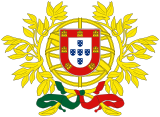Freguesia
| Freguesia | |
|---|---|
| Category | 3rd-level Assembleia de Freguesia |
 |
|---|
| Constitution |
Freguesia (Portuguese pronunciation:
A freguesia is a subdivision of a
Since the creation of a democratic local administration, in 1976, the Portuguese parishes have been ruled by a system composed by an executive body (the junta de freguesia, "parish board/council") and a deliberative body (the assembleia de freguesia, "parish assembly"). The members of the assembleia de freguesia are publicly elected every four years. The presidents of the parish boards are also members of the municipal assembly.[1]
History
The parish, in contrast with the municipalities, had their base in the ecclesiastical divisions that "had its origin in the fact that neighbours professed the same religion and professed their faith and divinity in the same temple".
Present situation
Portugal
Before the 2013 local government reforms, the 308 municipalities were subdivided into 4,259 civil parishes.
The reform was implemented according to Law 11-A/2013 of 28 January 2013, which defined the reorganization of the civil parishes.[6] This way, the number of parishes was reduced from 4,259 to 3,091.
Municipalities in Portugal are usually divided into multiple freguesias, but seven municipalities are not:
Portugal has no
Cape Verde
Of Cape Verde's 22 municipalities, which form the highest level of sub-national government in the small African state, some but not all are subdivided into parishes. There are 32 parishes in the country.
Macau
See also
- List of parishes of Portugal(freguesias)
- Bairro
- Civic and Municipal Affairs Bureau – replaced the former municipal councils during Portuguese rule of Macau, but retain the freguesias model
References
- ^ a b "7th Constitutional Revision" (PDF). Assembly of the Republic (Portugal). Archived from the original (PDF) on 22 October 2014. Retrieved 13 August 2014.
- ^ hdl:10216/19439.
- ^ a b c Gabinete do Ministro Adjunto e dos Assuntos Parlamentares, ed. (2011). "Documento Verde da Reforma da Administração Local" (PDF) (in Portuguese). Lisbon, Portugal: Governo da República. Archived from the original (PDF) on May 24, 2012. Retrieved 13 August 2014.
- ^ Data of the Official Administrative Charter of Portugal, 2011
- ^ a b "Governo e 'troika' acordam reduzir número de câmaras e freguesias" (in Portuguese). Lisbon, Portugal: RTP Online. 4 May 2011. Archived from the original on October 2, 2011. Retrieved 4 May 2011.
- ^ "Law nr. 11-A/2013" (PDF). Diário da República (in Portuguese). Assembly of the Republic (Portugal). Retrieved 13 August 2014.
Bibliography
- Francisco Cardoso de Azevedo (1901). Lista alphabetica das freguezias do continente do Reino e ilhas adjacentes (in Portuguese). Lisbon: Impresna Lucas.
